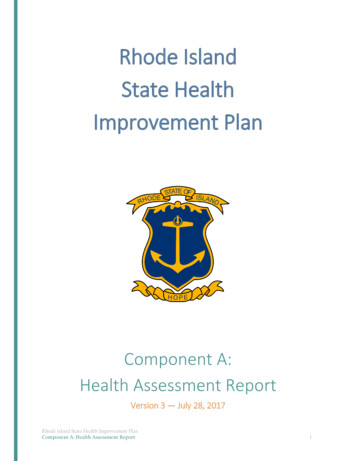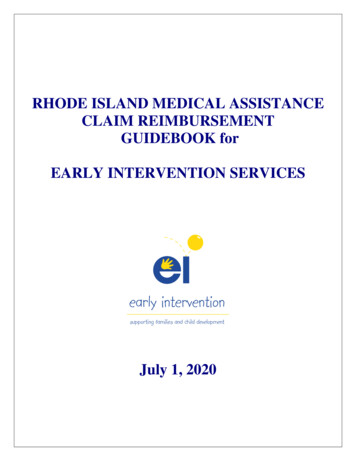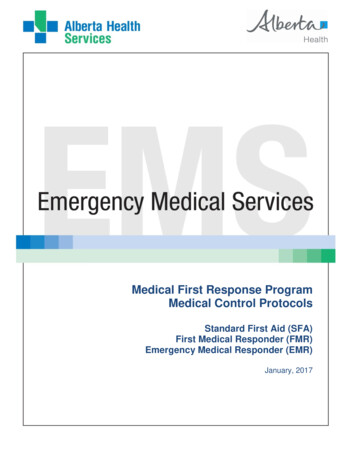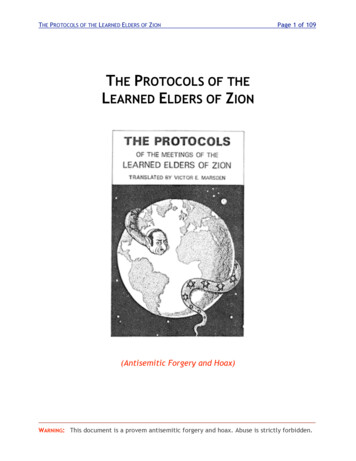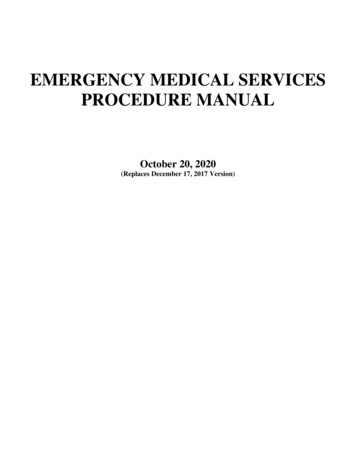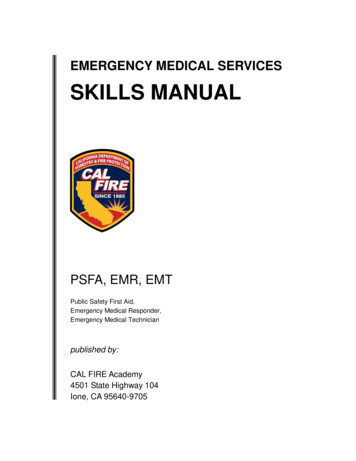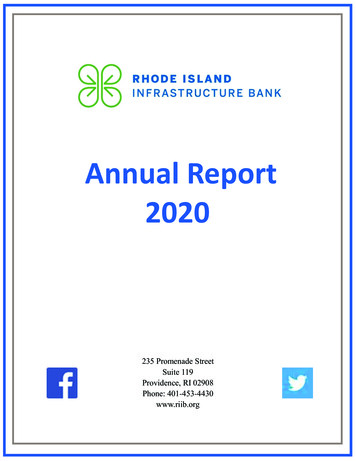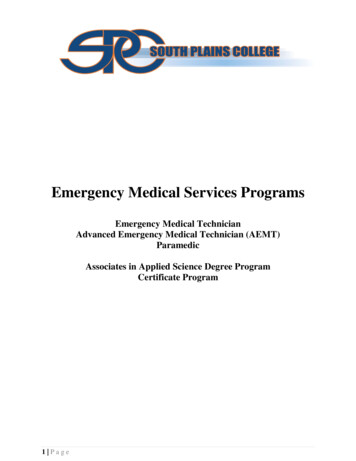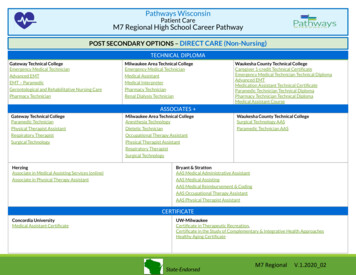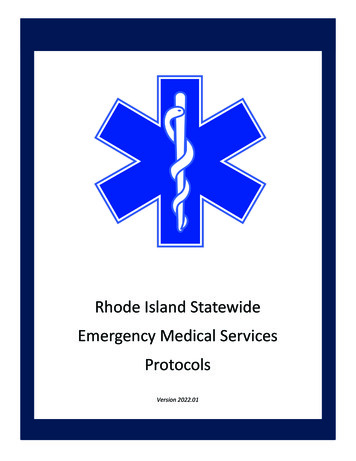
Transcription
Rhode Island StatewideEmergency Medical ServicesProtocolsVersion 2022.01
THIS PAGE INTENTIONALLY LEFT BLANK
These protocols are established by the Rhode Island Ambulance Service CoordinaƟngAdvisory Board. These protocols and standing orders shall supersede all protocolsand standing orders previously published.Contains all protocols effec ve April 10, 2022.Kenneth A.A WilliamsWilliams, MDMD, FACEPMedical DirectorJohnh PotviniChairperson, Ambulance Service Coordina ng Advisory Board
AcknowledgementsRhode Island Ambulance Service Coordinating Advisory Board (RI General Laws §23-4.1-2)John Potvin, NRP, EMS-IC, Chairperson, EMS Director, East Providence Fire Department, RISAFF*Michael DeMello, NRP, EMS-IC, Vice Chairperson, Chief, Bristol Fire Department, Bristol CountyRaymond Medeiros, AEMT-C, EMS-IC, Secretary, RISAFFHeather Rybasack-Smith, MD, Rhode Island Medical SocietyRyan Carter, MD, RI Chapter of the American College of Emergency PhysiciansLynne Palmisciano, MD, RI Chapter of the American Academy of PediatricsMichael Connolly, MD, RI Chapter of the American College of Surgeons, Committee on TraumaScott Partington, AEMT-C, Chief, Narragansett Fire Department, RI Association of Fire ChiefsJames Richard, NRP, EMS-IC, Captain, Cumberland Emergency Medical Services, RISAFFLori Poirier, NRP, EMS-IC, Lieutenant, Oakland-Mapleville Fire Department, RI State Firemen’s LeagueRichard Greene, AEMT-C, Deputy Chief, Cranston Fire Department, Kent CountyRandall Watt, AEMT-C, Captain, Little Compton Fire Department, Newport CountyVirginia Colwell, AEMT-C, EMS-IC, Commander, Foster Ambulance Corps, Providence County, volunteerGillian Cardarelli, NRP, Lieutenant, Providence Fire Department, Providence County, career departmentBethany Gingerella, RN, NRP, EMS-IC, Charlestown Ambulance-Rescue Service, Washington CountyLynn Blais, RN, RI Emergency Nurses AssociationDawn Lewis, PhD, RN, EMT, Hospital Association of Rhode IslandAdam Reis, RN, Chief, Access Ambulance, professional ambulance serviceJoseph Baginski, EMT, Chief, Professional Ambulance, professional ambulance serviceJoseph M. Polisena, RN, MEd., AEMT-C, EMS-IC, Town of Johnston Mayor, RI Senate President appointeeZachariah Kenyon, AEMT-C, EMS Chief, Providence Fire Department, RI Senate President appointeeMichael Carreiro, AEMT-C, Lieutenant, Warwick Fire Department, RI Speaker of the House appointeeKeith Calci, AEMT-C, Captain, Johnston Fire Department, RI Speaker of the House appointeeKathleen Barton, Public MemberDanielle Green, RN, Public Member*RISAFF is the Rhode Island State Association of Fire FightersSpecial thanks to:Division of Preparedness, Response, Infectious Disease & Emergency Medical Services (PRIDEMS),Center for Emergency Medical ServicesJames McDonald, MD, MPH, Director of HealthUtpala Bandy, MD, MPH, PRIDEMS Medical and Division Director, RI State EpidemiologistChristine Goulette, MAT, PRIDEMS Associate Director of HealthJason M. Rhodes, MPA, AEMT-C, EMS-IC, Chief, Center for Emergency Medical ServicesKenneth Williams, MD, FACEP, Medical Director, Center for Emergency Medical ServicesCarolina Roberts-Santana, DHSc, MHA, Deputy Chief, Center for Emergency Medical ServicesEric Rossmeisl, AEMT-C, EMS-IC, Training Coordinator, Center for Emergency Medical ServicesAnna Civitarese, MPH, EMS Epidemiologist, Center for Emergency Medical ServicesChristine Moniz, EMT, Field Technician, Center for Emergency Medical ServicesConstance Ball, MPA, Data Manger/MIH-CP Coordinator, Center for Emergency Medical ServicesHeather Seger, MSW, LICSW, QMHP, Behavioral Health Clinician, Center for Emergency Medical ServicesJodie Lavoie, Licensing Aide, Center for Emergency Medical ServicesJohn Pliakas, MSN, NP, NRP, TP-C, EMS-IC - Primary authorThese individuals selflessly and enthusiastically provided their expertise and extensive effort to ensure thisdocument is of the highest quality and adheres to contemporary medical standards. The State of RhodeIsland is truly grateful for their dedication to the emergency medical services community and to theresidents of our state.
Rhode Island Department of Health – Center for Emergency Medical ServicesStatewide Treatment Protocols - 2022.01Table of ContentsPreface:Use of ProtocolsSection 1:General Patient Care01.0101.0201.0301.0401.0501.0601.07Routine Patient CareDocumentationMedical ControlBiological DeathMobile Integrated Health / Community ParamedicineEmergency Medical Responder (EMR) Scope of PracticeAdvanced Emergency Medical Technician (AEMT) Scope of PracticeSection 2:Medical 02.25Acute Neurologic Event with Evidence of Increased ICPAbdominal PainAdrenal InsufficiencyAllergic Reaction / Anaphylaxis - AdultAllergic Reaction / Anaphylaxis - PediatricAltered Mental Status - AdultAltered Mental Status - PediatricBrief Resolved Unexplained EventPatient Comfort - AdultPatient Comfort - PediatricRespiratory Distress (Asthma/COPD/RAD) - AdultRespiratory Distress (Asthma/RAD/Croup) - PediatricBehavioral EmergenciesDiabetic Emergencies - AdultDiabetic Emergencies - PediatricDialysis Emergencies and Renal FailureIschemic StrokeIV tPA for Acute Ischemic StrokeEpistaxisFever - AdultFever - PediatricNeonatal ResuscitationObstetrical Delivery - LaborObstetrical ComplicationsSeizures - AdultSeizures - PediatricGeneral Shock and Hypotension - AdultGeneral Shock and Hypotension - PediatricHemorrhagic Shock - AdultHemorrhagic Shock - PediatricSeptic Shock - AdultSeptic Shock - PediatricSickle Cell CrisisSyncopeExcited Delirium
Rhode Island Department of Health – Center for Emergency Medical ServicesStatewide Treatment Protocols - 2022.01Table of ContentsSection 3:Cardiac 3.05P03.06A03.06P03.07A03.07P03.08Acute Decompensated Heart Failure/Pulmonary EdemaChest Pain - Acute Coronary Syndrome - STEMICardiac Arrest - AdultCardiac Arrest - PediatricPost Cardiac Arrest Care - AdultPost Cardiac Arrest Care - PediatricCardiac Dysrhythmia - Bradycardia - AdultCardiac Dysrhythmia - Bradycardia - PediatricCardiac Dysrhythmia - Narrow Complex Tachycardia - AdultCardiac Dysrhythmia - Narrow Complex Tachycardia - PediatricCardiac Dysrhythmia - Wide Complex Tachycardia - AdultCardiac Dysrhythmia - Wide Complex Tachycardia - PediatricCare of the Patient with a Ventricular Assist Device (VAD)Section 4:Trauma - Environmental - Toxicological tiple Trauma - AdultMultiple Trauma - PediatricHead Trauma - Traumatic Brain InjurySpinal Motion Restriction PrecautionsExternal Hemorrhage ControlExtremity and Musculoskeletal InjuriesTraumatic Cardiac ArrestThermal Burn Injury - AdultThermal Burn Injury - PediatricChemical and Electrical Burn InjuryCrush InjuryDental Trauma and EmergenciesOcular Trauma and EmergenciesHeat Related IllnessHypothermia and Localized Cold Injury - AdultHypothermia and Localized Cold Injury - PediatricSubmersion - Near DrowningDiving EmergenciesMarine EnvenomationBites - Stings - EnvenomationToxicological Emergencies - General - AdultToxicological Emergencies - General - PediatricToxicological Emergencies- Nerve Agent or Organophosphate ToxicityCarbon Monoxide ExposureBlast Injury IncidentRadiation Incident
Rhode Island Department of Health – Center for Emergency Medical ServicesStatewide Treatment Protocols - 2022.01Table of ContentsSection 5:Airway Protocols05.01A05.01P05.02A05.02P05.0305.04Airway Management - AdultAirway Management - PediatricFailed Airway - AdultFailed Airway - PediatricRespiratory distress in a patient with a Tracheostomy TubeMedication Assisted IntubationSection 6:Special 06.0906.10Multiple Patient Incident (Mass Casualty Incident)Helicopter Emergency Medical Services (HEMS)Medical Orders for Life Sustaining Treatment / Comfort OneRefusal of Patient Care or TransportInterfacility and Non-Emergent TransportPatient in Police CustodySpecialized Patient CareTermination of Resuscitation EffortsDeceased PersonsImmunizations (prerequisite restricted protocol)Section 7:Procedure 7.2207.2307.24Airway - Continuous Positive Airway Pressure (CPAP)Airway - Foreign Body Airway ObstructionAirway - Endotracheal Intubation – OralAirway - Endotracheal Intubation – NasotrachealAirway - Use of an Endotracheal Tube IntroducerAirway - Blindly Inserted Airway Devices (BIAD)Airway - CricothyrotomyAirway - Peak Expiratory Flow Rate MeasurementAirway - Use of Colorimetric EtCO2 DetectorAirway - Waveform CapnographyAirway - Suctioning (basic)Airway - Suctioning (advanced)Airway - Tracheostomy Tube ChangeAirway/Breathing - Nebulized Medication AdministrationAirway - Metered Dose Inhaler Medication AdministrationAirway/Breathing - Pulse OximetryAirway/Breathing - Mechanical VentilationCardiac - Multi-lead ECG AcquisitionCardiac - Carotid Sinus MassageCardiac - Defibrillation – AutomatedCardiac - Defibrillation – Manual
Rhode Island Department of Health – Center for Emergency Medical ServicesStatewide Treatment Protocols - 2022.01Table of .5507.5607.5707.6007.6107.6207.63Cardiac - Defibrillation – Double SequentialCardiac - CardioversionCardiac - Transcutaneous PacingCardiac - Mechanical CPR DeviceAssessment - Blood Glucose AnalysisAssessment - Esophageal Temperature Probe InsertionTreatment - Needle ThoracostomyTreatment - Ocular Irrigation - Morgan Lens Treatment - Gastric Tube InsertionTreatment - Patient RestraintTreatment - Pelvic Binder ApplicationTreatment - Use of an Auto-injectorTreatment - Subcutaneous and Intramuscular InjectionsTreatment - Tourniquet ApplicationTreatment - Hemostatic Dressing ApplicationTreatment - Wound CareTreatment - Intranasal Medication AdministrationTreatment - Nasal PackingTreatment - Expandable Multi-Sponge DressingTreatment - Procedure - Nitrous Oxide (N2O) AdministrationProcedure - Push-Dose Vasopressor PreparationVascular Access - Peripheral Vascular AccessVascular Access - IntraosseousVascular Access - Accessing Alternate Vascular DevicesVascular Access - Umbilical Vein CannulationSection 8:Special Operations08.00Fire Ground and Extended Operations Responder RehabilitationSection 9:Appendices09.0009.01FormularyStandard Concentrations for IV Admixtures
PrefaceUse of ProtocolsThese protocols delineate the scope of care for the three EMS provider levels recognized andlicensed by the Rhode Island Department of Health. Level specific care is denoted by letterscorresponding to each licensure level as below:EA/CDenotes the scope of care for the Emergency Medical Technician (EMT) practitioner.Denotes the scope of care for the Advanced EMT-Cardiac practitioner.PDenotes the scope of care for the Paramedic practitioner.ACPDenotes the scope of care for Advanced EMT-Cardiac and Paramedic practitioners.Care begins at level E for all providers. The scope of care for levels above the EMT practitioneris delineated in level respective sections as above (they do not build on each other). Example,the Paramedic level of care begins with the care delineated in the E section of a protocol andcontinues with the care delineated in the P section. If there are no subsequent leveldelineations beyond level E in a specific protocol, the care outlined in level E applies to all EMSpractitioner levels.If the directive “consider” is used for an intervention (procedure, medication, etc.), it isexpected the provider will use his/her best judgement in considering its appropriateness as itrelates to the patient at hand. In the event an intervention is deferred or executed, thepractitioner(s) must have a reasonable and well thought out rationale for its deferment orexecution.The Routine Patient Care Protocol applies to all patients. More than one protocol may apply toa single patient. Practitioners are expected to utilize all applicable protocols when managing apatient. If a patient’s presentation does not clearly meet the recognition criteria of a specificprotocol, practitioners should consult MEDICAL CONTROL for guidance.The PEARLS section contains useful information and in some cases, direction of care. Directionof care contained in the PEARLS section is considered part of the protocol and it is expectedthat providers will follow this direction as applicable.Some protocols are adult or pediatric specific. These protocols are identified by the letter Afollowing the protocol number for an adult specific protocol or by the letter P and a teddybear logo for a pediatric specific protocol.This document is embedded with hyperlinks identified by Blue underlined - text. The table of contents is blue but not underlined, but do contain hyperlinks to eachindividual protocol.Table of contents sections are hyperlinked to each individual sectionAt the bottom of each protocol, clicking the table of contents sign returns to the section ofthe protocol, and the section title returns to table of contents.These protocols are a “living document” maintained electronically by the Center forEmergency Medical Services (CEMS) and, as such, may be edited or updated as required atany time. A detailed review and editing of these protocols will occur on an annual basis and anupdated version will be released every January.stSuggestions and supporting evidence andliterature must be received by CEMS by March 31 of the preceding year for consideration forinclusion in the January revision. The intention is to include references, recommended readingand links to related educational materials in future editions.
THIS PAGE INTENTIONALLY LEFT BLANK
Section 1: General Patient Care01.0101.0201.0301.0401.0501.0601.07Routine Patient CareDocumentationMedical ControlBiological DeathMobile Integrated Healthcare / Community ParamedicineEmergency Medical Responder (EMR) Scope of PracticeAdvanced Emergency Medical Technician (AEMT) Scope of Practice
THIS PAGE INTENTIONALLY LEFT BLANK
1.2.3.4.E5.6.7.8.9.10.11.Respond to the scene in a safe manner: Use information available from the dispatcher, consider scene safety andpre-arrival assessment and treatment of the patient. Request appropriate additional resources, including advanced life support(ALS) response / intercept if available. Use of emergency warning devices and siren should be used withdiscretion and only as appropriate for the nature of the response andgiven information.Approach the scene cautiously and assess scene safety: If a hazard is identified, request appropriate assistance and maintainscene safety through appropriate measures including the use of personalprotective equipment (PPE) as indicated. If the scene is unsafe, stage untilhazards / threats are mitigated. Utilize standard precautions for all patient contacts. Standard precautionsinclude, depending on the anticipated degree or exposure, the use ofgloves, gowns, mask, and eye protection or a face shield. Hand hygieneshould be performed before and after each patient contact. Institutetransmission based precautions as indicated in Table 1 below. Bring all necessary equipment to the patient.Utilize the Multiple Patient Incident (Mass Casualty Incident) Protocol ifindicated based the number of patients and/or need for resources.Determine if the patient(s) meet pediatric or adult criteria by age. A pediatricpatient is defined as a patient less than 16 years of age. For patients 36kg/80 lbs., utilize a pediatric dosing device (Broselow , Handtevy or other). Ifthe Broselow Pediatric Emergency Resuscitation Tape is utilized, patientsmeasuring beyond the length of the tape should receive weight basedmedication dosing until the age of 16 years old or their total body weight is 50kg. Some special needs patients may require continued use of pediatricprotocols regardless of age.For trauma patients, evaluate mechanism of injury (MOI) and employ spinalmovement restriction precautions (SMRPs) if indicated following the SpinalMovement Restriction Precautions Protocol.Obtain and document the patient’s chief complaint (CC), history of thepresent illness (HPI), past medical history (PMH), current medications(including over-the-counter medications) and allergies to medications.Perform a primary assessment and obtain vital signs. Vital signs at a minimumshall include blood pressure (BP), palpated pulse, respiratory rate, and oxygensaturation as measured by oximeter (SpO2). Temperature (oral, rectal, axillary,or esophageal probe) should be obtained and documented when availableand in all critically ill or injured pediatric patients.Perform a secondary assessment (the secondary assessment may consist of afocused examination for isolated injuries).Treat life-threatening conditions in the order in which they are identified.Manage as indicated per age appropriate protocol(s).All patients shall have their level of pain assessed utilizing an age appropriatepain scale (see age appropriate Patient Comfort Protocol). This assessmentshall be documented on the Patient Care Report.Pain, nausea and vomiting should be managed following age appropriatePatient Comfort Protocols.1.01Routine Patient CareRoutine Patient Care1.01
1.01Routine Patient Care12.13.14.Routine Patient Care15.E16.17.1.0118.19.20.Provide airway management when indicated following age appropriateAirway Management Protocols. All intubated patients, including thoseundergoing interfacility transfer, must have the airway monitored withquantitative waveform capnography.For patients with dyspnea/shortness of breath, chest pain/discomfortpresumed to be of cardiac etiology and/or with a SpO2 of 94%, oxygenshould be administered via appropriate delivery device to maintain the SpO2in a range of 94-99%. During cardiopulmonary resuscitation (CPR) oxygenshould be administered at the highest FiO2 possible. Once return ofspontaneous circulation (ROSC) is achieved, the FiO2 should be titrated to thelowest concentration required to maintain the SpO2 in a range of 94-99%.Advanced life support (ALS) providers may establish intravenous (IV) access inany unstable or potentially unstable patient or when required for protocoldirected therapeutic intervention (e.g., analgesia, treatment of nausea orvomiting, etc.). 0.9% saline solution is the fluid of choice for “keep veinopen” (KVO) purposes and limited fluid boluses. Unless otherwise directed byprotocol, Lactated Ringers is the fluid of choice for significant fluidresuscitation for shock and burn injury. The KVO rate for the adult patient is20-30 ml/hour and in the pediatric patient 10-20 ml/hr. Flow rates should beadjusted as directed by protocol. When appropriate, an intermittent needletherapy (INT) device (a.k.a. saline lock) may be placed in lieu of an infusing IV.Intraosseous (IO) access is interchangeable with IV access and reference tothe IV route of medication administration is inclusive of the IO route.Pediatric maintenance IV fluids should be calculated as follows: 4ml/kg for thefirst 10 kg 2 ml per the second 10 kg plus 1 ml for each additional kg.All intravenous infusions, unless exempted in Appendix 09.01, must beadministered via an electronic infusion pump. See Appendix 09.01 forStandard Concentrations for IV Admixtures.A multi-lead ECG ( 12 lead) should be obtained, if available, in any patientpresenting with signs or symptoms suggestive of cardiac ischemia/infarction(chest pain/discomfort, known or suspected anginal equivalent, non-specificGI distress in an elderly female or diabetes, etc.) and in all patients postmedical cardiac arrest with ROSC.All procedures (successful and unsuccessful attempts) shall be documentedon the Patient Care Report (PCR). Documentation shall include at a minimum:the procedure, device used, anatomic location, number of attempts, providerperforming the procedure, and any noted complications.Communicate with MEDICAL CONTROL as indicated and/or provide entrynotification to receiving hospital facility. EMS practitioners may consultdirectly with a MEDICAL CONTROL physician at any time they feel suchcommunication may be helpful in the care of a patient. Entry notification tothe receiving hospital facility shall occur via electronic communication utilizingthe RI Patient Tracking System (PTS). It may also occur via direct voice contactutilizing telephonic or radio communication.Transport the patient to the nearest appropriate Hospital Emergency Facility(see Table 2 - Point of Entry - Specialized Hospital Emergency Facilities).Patients in respiratory or cardiac arrest should be transported to the nearestHospital Emergency Facility unless otherwise directed by MEDICAL CONTROL.Providers should recognize and consider that, absent an acute life threateningcondition or a condition requiring transportation to a specialized care facility,the most appropriate transport destination may be a facility at which thepatient is followed or receives care (this facility may not be thegeographically nearest).
21.22.23.E24.25.26.Some patients who are beyond the pediatric age limit with chronic medicalconditions may request or require transportation to a Pediatric Specialty CareFacility.During transportation: Stretcher patients shall be secured in an appropriate restraint systemproviding both transverse and longitudinal protection. Straps arerequired at the patient’s knees, hips, and over the shoulders. Ambulance cots shall be positioned at the lowest possible position duringtransportation and movement of the patient. Seated patients shall be restrained with a lap and chest safety beltrestraining system. Pediatric patients of appropriate age, height or weight shall betransported utilizing a restraint system (child safety seat) compliant withFederal Motor Vehicle Safety Standards (FMVSS). The car safety seat shallbe properly affixed to a stretcher with the head section elevated or to avehicle seat, unless the patient requires immobilization of the spinalcolumn, pelvis, or lower extremities; or the patient requires resuscitationor management of a critical problem. All heavy items and equipment (e.g. cardiac monitors, oxygen cylinders)in the patient care compartment of the ambulance shall be securedfollowing the manufactures specifications. Use of emergency warning devices and siren are to be restricted to useonly while transporting patients with acute life threatening conditionsrequiring time sensitive interventions.The following may be used as a reference for pediatric age appropriate systolicblood pressure:Neonate 60 mmHgInfant to 1 year 70 mmHg1-10 years 70 (2 x age in years) 10 years 90 mmHgA face to face verbal report (hand-off) detailing the patient’s chief complaint,abnormal assessment findings, EMS interventions, and the patient’s responseto treatment shall be given to a licensed health care provider at the receivingfacility.All care shall be documented in accordance with the Documentation Protocolon an ePCR.Direct patient care provided by a non-transporting R.I. licensed ambulance(i.e. fire suppression unit, ALS intercept, etc.) must be documented by thecompletion of an ePCR by the licensed EMS providers staffing the unit andproviding care. This may result in the generation of two ePCRs within oneservice for the same patient/incident.1.01Routine Patient CareRoutine Patient Care1.01
1.01Routine Patient CareTable 1 - Transmission Based PrecautionsRoutine Patient CareCategoryCategory ComponentsClinical ApplicabilityContactStandard precautions use ofgloves during patient contactand when touching the patient’simmediate environment orbelongings, changing of gownsand gloves after every patientcontact, cleaning and disinfectingall surfaces and reusableequipment, and strict handwashing.Norovirus, rotavirus, enterovirus,Clostridium difficile, acute diarrhea ofunknown etiology, respiratorysyncytial virus (RSV), adenovirus,multidrug resistant organisms (MRSA,VRE, ESBLs, VISA/VRSA), scabies/headlice, herpes zoster (shingles) withdisseminated disease, varicella(chickenpox), herpes simplex virus(HSV) in neonates, drainage (abscess,cellulitis, ulcer, burn or wound) notcontained adequately by dressing ornot dressed, impetigo or rash ofunknown etiology.DropletStandard precautions standardsurgical mask for providersaccompanying patient in theback of the ambulance or within3 feet of the patient and asurgical mask or non-rebreathermask on the patient.Influenza, parainfluenza, parvovirus,meta-pneumovirus, rhinovirus,adenovirus, respiratory syncytial virus(RSV), bronchiolitis, meningitis,mumps, group A streptococcalpharyngitis in infants and children,infectious rash, pertussis (whoopingcough) upper respiratory infections;including unknown infections prior toorganism ID.AirborneStandard precautions N95respirator mask or powered airpurifying respirator [PAPR]).Tuberculosis (TB) or symptomsconsistent with pulmonary TB (nightsweats, fever, hemoptysis,unexplained weight loss),Mycobacterium tuberculosis, measlesrubeola, varicella (chickenpox),herpes zoster (shingles) withdisseminated disease, vesicular (fluidfilled) rash, SARS-CoV-2.E1.01Notes Hand hygiene is required before and after each patient contact for all patients.Clostridium difficile and acute diarrhea of unknown etiology require soap andwater hand hygiene.Some pathogens require the use of a combination of precaution categories (e.g.,varicella zoster (chickenpox) requires standard precautions airborne precautions contact precautions).
1.01Routine Patient CareRhode Island HospitalACS Verified Level 1 Trauma Centers – PediatricHasbro Children’s HospitalABA Verified Adult Burn CentersRhode Island HospitalABA Verified Pediatric Burn CentersHasbro Children’s HospitalComprehensive Stroke CentersRhode Island HospitalPrimary Stroke Centers &Acute Stroke Ready Hospitals (ASRH)Kent HospitalLandmark Medical CenterMiriam HospitalNewport HospitalOur Lady of Fatima HospitalRoger Williams Medical CenterSouth County HospitalWesterly Hospital (ASRH)Day Kimball HospitalLawrence and Memorial HospitalPrimary PCI Capable HospitalsKent HospitalLandmark Medical CenterMiriam HospitalRhode Island HospitalCharlton Memorial HospitalLawrence and Memorial HospitalSt. Anne’s HospitalEmergency Hyperbaric Oxygen ChamberKent HospitalMassachusetts General HospitalPediatric Specialty Care HospitalHasbro Children’s HospitalMental Health Preferred FacilitiesLandmark Medical CenterNewport HospitalOur Lady of Fatima HospitalRhode Island HospitalRoger Williams Medical CenterEOpioid Use Disorder Preferred FacilitiesKent HospitalLevel 1 or 2 as designated by RIDOH and BHDDH Miriam HospitalNewport HospitalOur Lady of Fatima HospitalRhode Island HospitalRoger Williams Medical CenterRecovery Navigation Program or Mental Healthand Opioid Use Disorder FacilityBH Link – 975 Waterman Avenue,East Providence, RI401-414-5465 (LINK)Routine Patient CareACS Verified Level 1 Trauma Centers - Adult1.01Table 2- Point of Entry - Specialized Hospital Emergency Facilities
THIS PAGE INTENTIONALLY LEFT BLANK
1.02Documentation2.3.4.5.6.E7.All patient contacts with a RI licensed ambulance service must bedocumented.All documentation must be performed electronically utilizing a NationalEmergency Medical Services Information System (NEMSIS) complaintsoftware platform. The version will be determined by the Center for EMS.The use of paper documentation is only acceptable in the event of electronicdocumentation failure. Paper documentation may not be used as a“placeholder” for electronic documentation.Receiving facilities shall be provided a completed copy of the patient carereport (PCR) proximate to patient arrival. In the event this is not possible, thePCR will be completed and provided to the receiving facility as soon aspossible and no greater than 2 hours after patient handoff. An explanation inthe narrative section of the PCR should explain any delay in the provision of aPCR to a receiving facility and should indicate the means used to deliver thereport and confirm that it was received.PCR data shall be transmitted or otherwise provided to the Center ofEmergency Medical Services (CEMS) in the timeframe specified in the RhodeIsland Code of Regulations, Emergency Medical Services [216-RICR-20-10-2].In addition to required patient demographics, the following shall bedocumented in the narrative section of the PCR for each patient contact (if aparticular data point is not applicable or is unobtainable, it should bedocumented as such):⃝Chief complaint;⃝Mechanism of injury (if applicable);⃝Source of information (if not from the patient);⃝History of present illness or injury:⃝Past medical history;⃝Family and social history (only if relevant);⃝Medications;⃝Medication or other significant allergies;⃝Physical examination findings (may be a focused examination for isolatedinjuries/complaints);⃝ECG interpretation and other point of care lab data (i.e. finger stick bloodglucose);⃝Assessment (presumptive field diagnosis); and⃝All interventions and an evaluation of the effect or response.All procedures and procedure attempts shall be documented. Documentationof the following is required for all procedures:⃝anatomic location (if applicable);⃝number of attempts;⃝ /- success;⃝name of the provider (s) performing or attempting the procedure;⃝complications;⃝and patient response (if applicable).⃝Documentation elements specified in individual procedure protocolsshall also be included.Documentation1.1.02Recognition Documentation is the highest level of EMS professional accountability. The EMS patient care report (PCR) is part of the patient’s permanent medical record and isoften examined by other medic
Lynn lais, RN, RI Emergency Nurses Association Dawn Lewis, PhD, RN, EMT, Hospital Association of Rhode Island . 06.03 Medical Orders for Life Sustaining Treatment / omfort One 06.04 Refusal of Patient are or Transport 06.05 Interfacility and Non-Emergent Transport 06.06 Patient in Police ustody .
